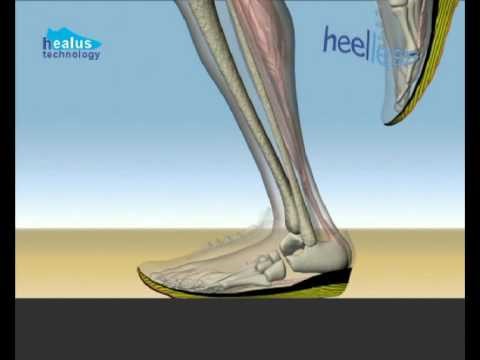Introduction
The focus of this analysis is on the biochemical, not so much the biomechanical, although the biochemical responses of the body are closely linked to the forces that one puts on the body.
All overuse running injuries could be classified as training errors, and thus, all such injuries could be prevented with the right volume, duration, intensity and frequency of running. The person has too many times put high forces on a certain musculoskeletal structure. This too much is in relation to the resilience of these tissues.
Good training applies the right amount stresses, as such that that resilience of, for example tendon tissue, increases, and the person gets fitter. This phenomenon is called “mechanotransduction” and brings about strengthening of the muscle tissue, the tendon’s connective tissue in response to loading regimes [2].
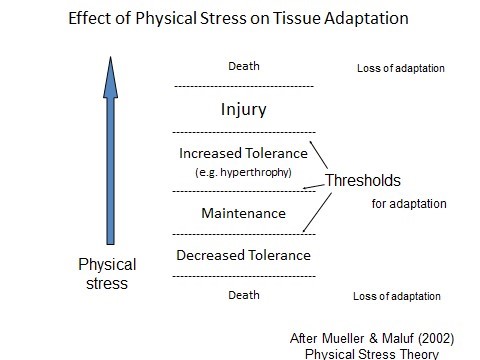
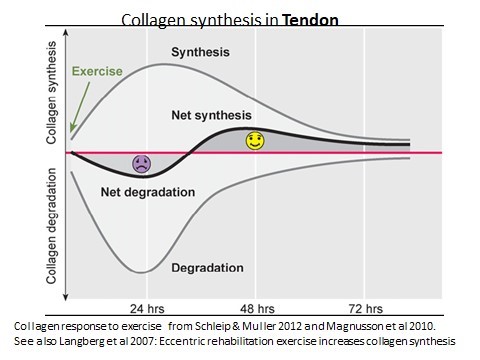
Training programmes reflect the planning of such work outs with the aim of achieving super-compensation without incurring an overuse injury. Super-compensation is the post training period during which the trained function/parameter has a higher performance capacity than it did prior to the training session. Timing of the sessions is important because of the time dependency of muscle protein breakdown and synthesis, which is the mechanism that provides the clearest rational for training adaptation.
When the training programme is right, when the right volume, duration, intensity and frequency of, for example running, are right, all such injuries are prevented. The person recovers from the bout and achieves super-compensation: the patient, the client, the athlete is a little bit stronger days after the session.
For this to happen, the total muscle protein synthesis needs to be greater than the muscle protein breakdown at every micro-cycle of training.
Reviews on the physiology experiments of muscle protein synthesis (MPS), generated over the last 20 years, have reflected on the intensity of the loading and the timing of the loading [5,6]. However these data have not yet been incorporated into a training model that reflects on various intensity workouts throughout a standard micro-cycle: a week.
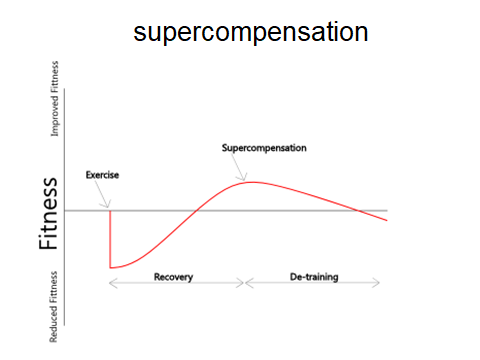
Methodology
We have used the evidence from the extensive body of research to describe a training model that optimises both rehabilitation from sports injuries and endurance training. We brought this information into a model graph that presents the fitness and fatigue levels over the period of a week of training. This will guide the athlete and the coach on the intensity levels of the various workouts during a standard micro-cycle of training: a week.
Results
A certain level of stress is needed to increase a person’s adaptive capacity. Eustress [3,4], typically experienced during lower intensity workouts, will bring about this adaptation in the treatment of sports injuries, such as tendinopathies. Eustress is an old concept, first introduced by Hans Selye 80 years ago. Easy runs in the park, walking up staircases, hikes up and down hills is what gets people fitter, stronger, more resilient. Longer term this is what gets tendon, muscles, bones and joints adapted to withstand stress the forces the human body is designed to endure.
We can estimate how long it takes for a certain type session to recover from, which gives us indications of how to build a training programme and achieve super-compensation.
Atherton and Smith [5] reviewed the research, especially the recent work using stable isotope tracers. It gave us a lot more information on how the body adapts following bouts of training. It consistently revealed that exercises need to be at intensities greater than 60% of capacity to create any muscle protein synthesis. This muscle protein synthesis takes places in the hours after the exercises, after the training session and never continues for longer than two days.
With untrained individuals, the intensity and volume needed to give net muscle synthesis is much lower than with trained athletes. In the trained state exercise-induced increases in MPS are shorter lived and peak earlier than in the untrained state, resulting in a smaller overall muscle protein synthetic response [6]. Therefore, for trained athletes who experience a plateau of performance levels and do not progress any further with their rehabilitation, there is a need to plan training with higher intensity workouts. High intensity exercise leads to muscle protein breakdown that is initially higher than MPS [5].
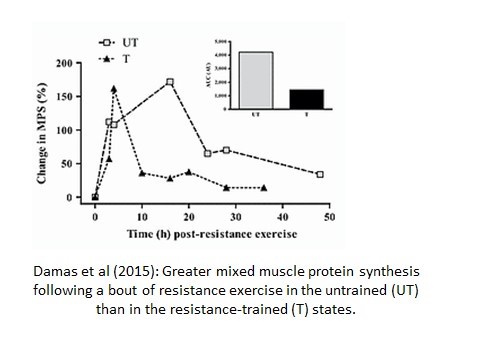
Exercises with sufficient resistance are needed to induce net muscle synthesis for atrophied muscles and tendons with degeneration after an injury. In a tendon rehabilitation programme the right training programme for the individual, carried out at the right level of forces and duration, is obviously at a reduced level than before the injury occurred. This will give the resilience building that is needed to get tendon regeneration, to get the strength, the elasticity and the endurance back in the tendon. Only the right programme at the right intensity with the right progression will get the athlete back to race fitness, and will lead the untrained office worker back to full health and fitness.
These models will guide the athlete and guide the patient and his / her coach, physiotherapist, podiatrist or personal trainer on the intensity levels of the various workouts during a standard micro-cycle of training: a week.
An example of an effective micro-cycle of training and rehabilitation is portrayed in the below figure. The athlete only improves their endurance and tendon strength if the sessions after the high intensity session are at a lower intensity. Only then there will be more muscle protein synthesis than muscle protein breakdown with as a result super-compensation.
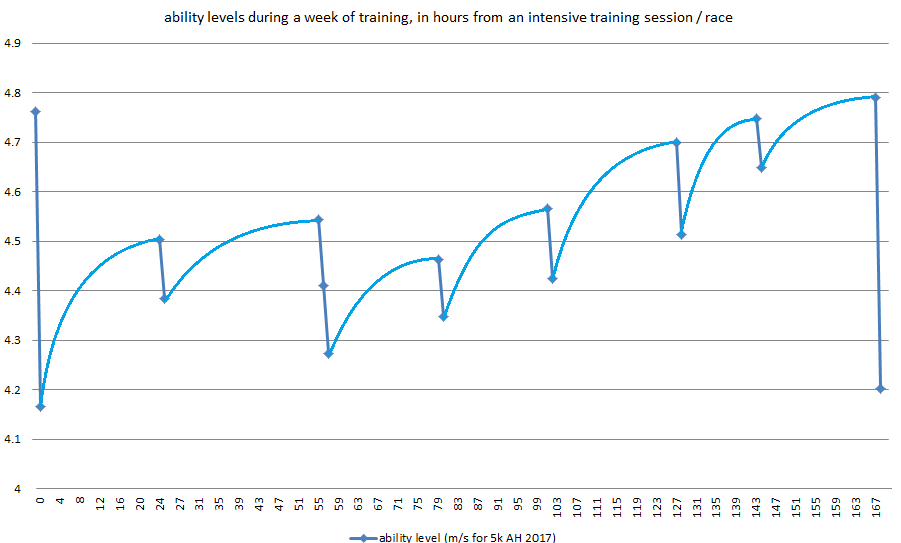
Figure. In this example of fluctuations of muscle endurance levels during a week of training there is a high intensity training session at the start of the week. In the remaining days of the week there are once daily medium and low intensity training sessions. Only after 7 days the athlete achieves “super-compensation” and is ready to put in another high intensity training session.
Conclusion
The re-building of the muscle and tendon and the recovery from high intensity training sessions and workouts often take up to 7 days. Because the muscle protein synthesis response from a training session only lasts up to 2 days [5,6], a trained person requires further sessions during the week to build their muscles and tendons. The long established principles of training plans and super-compensation used in strength and endurance training need to be used in the prevention, treatment and rehabilitation of tendinopathies and enthesopathies.
References
- Oestergaard Nielsen, R. et al (2012), “Training Errors and Running Related Injuries: a systematic review” IntJ Sports Phys Ther., 7(1): 58–75.
- Kan, K.M. & Scott, A. (2009), “Mechanotherapy: how physical therapists’ prescription of exercise promotes tissue repair”, Br J Sports Med, 43, 247-251.
- Kupriyanov, R. & Zhdanov, R. (2014), “The Eustress Concept: Problems and Outlooks” World Journal of Medical Sciences 11 (2): 179-185.
- Szabo et al (2012) “The legacy of Hans Selye and the origins of stress research: A retrospective 75 years after his landmark brief “Letter” to the Editor of Nature”, Stress, 15(5): 472–478.
- Atherton, P.J. and Smith, K. (2012) “Muscle protein synthesis in response to nutrition and exercise” J Physiol., 590: 1049–1057.
- Damas et al (2015) “A Review of Resistance Training-Induced Changes in Skeletal Muscle Protein Synthesis and Their Contribution to Hypertrophy” Sports Med. 45, 801 –807.
This article was written by Adri Hartveld (Mr) MSc MCSP and presented at the Staffordshire Conference for Clinical Biomechanics 2017.
If you would like to download a copy as a PDF then please CLICK HERE
